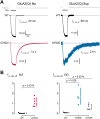Clinical and Neurodevelopmental Characteristics of Paralogous Gain-of-Function Variants at GRIA2 p.Gly792 and GRIA3 p.Gly803
- PMID: 40391499
- PMCID: PMC12501675
- DOI: 10.1111/cge.14770
Clinical and Neurodevelopmental Characteristics of Paralogous Gain-of-Function Variants at GRIA2 p.Gly792 and GRIA3 p.Gly803
Abstract
GRIA-related disorders arise from disease-causing variants in GRIA1, GRIA2, GRIA3, or GRIA4 that encode α-amino-3-hydroxy-5-methyl-4-isoxazole propionic acid (AMPA)-type glutamate receptors (AMPARs). Rare monoallelic GRIA1-4 variants affecting AMPAR function can potentially lead to neurodevelopmental disorders. The impact on AMPAR function may manifest as either gain-of-function (GOF) or loss-of-function (LOF). We recruited nine unrelated patients with either known disease-causing GOF variants in GRIA3 at position p.Gly803 or variants at the paralogous position in GRIA2 (p.Gly792). Specifically, five patients carried a de novo GRIA3 variant (p.Gly803Glu or p.Gly803Val), one carried a maternally inherited GRIA3 variant (p.Gly803Ala) and three carried de novo GRIA2 variants (p.Gly792Arg, p.Gly792Val, or p.Gly792Glu) which we demonstrate are also GOF. Recurrent symptoms included developmental delay affecting both motor skills and language abilities; cognitive impairment; behavioral and psychiatric comorbidities; hypertonia, cerebral palsy, non-epileptic myoclonus, and treatment-resistant epilepsy. We also provide insights into social skills, levels of autonomy, living arrangements, and educational attainment. We compared the clinical features associated with the two paralogous GOF GRIA2 and GRIA3 variants. Our study elucidates the developmental aspects, cognitive abilities, seizure profiles, and behavioral challenges associated with these variants and contributes to advancing our understanding and treatment of patients affected by this rare condition.
Keywords: AMPAR; epilepsy; natural history; neurology; syndrome.
© 2025 The Author(s). Clinical Genetics published by John Wiley & Sons Ltd.
Conflict of interest statement
The authors declare no conflicts of interest.
Figures



References
-
- Coombs I. D., Ziobro J., Krotov V., Surtees T. L., Cull‐Candy S. G., and Farrant M., “A Gain‐Of‐Function GRIA2 Variant Associated With Neurodevelopmental Delay and Seizures: Functional Characterization and Targeted Treatment,” Epilepsia 63, no. 12 (2022): e156–e163, 10.1111/epi.17419. - DOI - PMC - PubMed

